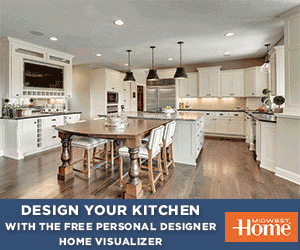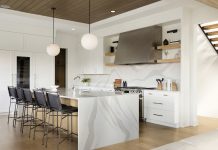
Above: this new home in the Rolling Green neighborhood of Edina eases living and entertaining inside and out, thanks to the flow of the kitchen, dining area, and three-season porch. Built by John Kraemer & Sons; designed by Sharratt Design & Company; interiors by Engler Studio Interior Design; and landscape by Topo.
Homes designed and built for affluent homebuyers showcase stunning locations, expansive spaces, sumptuous finishes, and the latest technology. All, however, have one thing in coming: They are customized to suit.
Depending on the owner, that may mean a kitchen detailed to the cook’s (or cooks’) specifications. Is there a coffee aficionado in the family? A custom-designed space for the espresso machine, burr grinder, cups, and favorite accouterments is made to order. Oenophiles? A convenient wine room for storage, right around the corner from the kitchen/living area, may replace the traditional wine cellar stashed away in the lower level.
High-end clients want spaces that work for how their families live, emphasizes Carrie Ellington, design director at Martha O’Hara Interiors in Minneapolis. “Gone are the days of worrying about resale and designing for what the future buyer might want, especially in new construction.” Her clients want high-end appliances, perfectly placed laundry rooms (perhaps a second laundry in the master suite), statement bathrooms, outdoor living spaces, and comfortable furnishings with durable fabrics for kids and pets.
 Above: The Rolling Green home’s three-season porch.
Above: The Rolling Green home’s three-season porch.
New vs. Old
For many buyers, that means building new, especially when the inventory of existing homes is as tight as it is in the current real estate market—thus the surfeit of teardowns around Lake Minnetonka, Edina, and other desirable neighborhoods. In those areas, older homes—even those in the multi-million-dollar range—don’t have the modern amenities that buyers want: high ceilings, huge expanses of glass, and open floor plans.
“Most of our clients have lake views or acreage views, and they want to see through to the back of the house,” says John Kraemer of John Kraemer & Sons in Edina. They also want 9- or 10-foot ceilings in the basement, full automation, and state-of-the-art HVAC and insulation systems, he notes. “You just don’t get that in a remodel or retrofit.”
Even when looking at existing homes, younger buyers—35- to 45-year-olds in prime child-rearing years—tend to gravitate toward newer ones, says Realtor Barry Berg of the Berg Larsen Group, longtime specialist in the Calhoun-Isles neighborhood of Minneapolis. “They look at older homes that may have been extensively remodeled, and they don’t see the need for large living and dining rooms. They’re more motivated by the floor plan, the function, and use of space.”
Not so much by the size of space. Berg finds that younger buyers in this area don’t need or want homes as large as those 9,000 square-foot manses that baby boomers once coveted; they want 3,500 to 4,500 square feet of quality space that functions well. They are also dialed into the location and the experience it engenders, says Berg.
More baby boomers and younger buyers alike want to leave the car at home, and walk or bike. They have made moving into downtown fashionable, and several suburbs—think Edina and Wayzata—are creating additional density and a more urban walkability.
 Above: The front entry, stair tower, and porte cochère beyond at Tramonto in Eden Prairie.
Above: The front entry, stair tower, and porte cochère beyond at Tramonto in Eden Prairie.
Connections
The desire for connections to the outdoors also drives luxury buyers toward newer construction. Says Berg, “They want houses that open as much as possible to the outdoors: terraces, kitchens, entertainment, and relaxing spaces.”
In new construction, screen porches—outdoors rooms with grills, TVs, and lounging and dining areas—are invariably part of the package. Likewise, walls of windows are de rigueur in homes that overlook a beautiful bay or a woodland vista. More is definitely considered better when it comes to sightlines on million-dollar views.
“Pocketing exterior door systems make large expanses of glass and huge openings,” points out Jeff Murphy, president and director of design at Murphy & Co. Design in Minneapolis. Those disappearing walls allow living spaces to continue right onto the terrace or patio. Paired with power screens that keep out flying pests, the outside becomes part of the inside.
Whether on a lake or not, many buyers include a swimming pool on their list of must-haves. Multifunctional pool houses are another amenity, says Murphy, the most luxurious including a living/cabana area for parties, guest suite, bathroom, washer and dryer, swim-suit dryer, and outdoor shower.
In addition to a pool, Peter Hagstrom of Hagstrom Builder in Lake Elmo finds that more clients want the pool—and the new home—to be well-landscaped. Wary of finding themselves at the end of the project with no budget left for the outdoor design, they set aside a healthy portion—say, 10 percent of the total budget—for landscaping. “They want immediate curb appeal,” says Hagstrom.
 Above: the home’s sport court and exercise room feature a timber-framed glass wall. Designed by Murphy & Co. Design; built by John Kraemer & Sons; interiors by Manor House Interiors; and landscape by Topo.
Above: the home’s sport court and exercise room feature a timber-framed glass wall. Designed by Murphy & Co. Design; built by John Kraemer & Sons; interiors by Manor House Interiors; and landscape by Topo.
The Nerve Center
We all know where people gather in most homes: the kitchen. “It’s the critical area in a home. We see that in the eyes and body language of every buyer,” says Realtor Berg.
The kitchen really functions as a living room, says Murphy. His advice: “Let’s welcome that fact and make the kitchen live really comfortably.” That’s why islands may be designed to be more like tables—sometimes even incorporating a banquette—rather than simply with bar seating. Why line up on one side of the island when you can build in a more congenial arrangement?
Frequent entertainers often require dual pantries, says Murphy. “Pantries have become so gorgeous now that you have a side pantry for food and canned goods, and a nicer looking butler’s pantry for pouring wine or using as a catering station for large parties.”
The bespoke nature of a luxury home is often expressed in the kitchen. In a new 10,000-square-foot home in Wayzata, Jolynn Johnson of Crystal Kitchen + Bath in Crystal recently designed a sizable kitchen for the young family.
Since both husband and wife cook together—and get the kids involved as well—Johnson created two separate work triangles, and customized every feature to the couple’s needs: no upper cabinets (the wife didn’t like them); base cabinets with drawers configured precisely for their dishes, pots, pans, and accessories; space for two toasters (his and hers); a cabinet solely for paper towel storage (she doesn’t do dish towels); and a charging station beneath the desk’s toe kick for robot vacuums.
Wolf and Sub-Zero are the appliances of choice for high-end kitchens—which usually include a separate wine cooler and a steam oven. For those who prefer a sleeker European look, Miele is a popular choice, says Johnson.
 Above left: This large kitchen features two separate work triangles to accommodate a household that cooks as a family. Above right: The sleek design boasts 12 appliances—including a 60-inch rangetop and hood—an island with table seating for four, and loads of customized storage space, such as the roll-up tambour for his and her toasters. Kitchen design by Crystal Kitchen + Bath; built by Heritage Construction; architect, KK.Design.
Above left: This large kitchen features two separate work triangles to accommodate a household that cooks as a family. Above right: The sleek design boasts 12 appliances—including a 60-inch rangetop and hood—an island with table seating for four, and loads of customized storage space, such as the roll-up tambour for his and her toasters. Kitchen design by Crystal Kitchen + Bath; built by Heritage Construction; architect, KK.Design.
Amenities
Luxe customization doesn’t stop in the kitchen. Master bath features are popular splurges—sometimes including a spectacular freestanding tub as a centerpiece, sometimes no tub at all but a two-person shower with multiple showerheads. Johnson recalls measuring the placement of one of eight showerheads to hit the homeowner’s back exactly in the spot he wanted.
When it comes to closets, they get bigger every year, observes builder Hagstrom. His and her closets are common requests, and refinements in closet systems means homeowners can indulge their every whim. The high end these days: Rimadesio, a sophisticated Italian closet system available locally through DOM Minneapolis + Valcucine. “It’s the Ferrari of closets,” says Hagstrom.
Additional popular requests, says Murphy, include golf simulators and sport courts. But the latter aren’t just for basketball. More are built as multiuse spaces: A movie screen descends from the ceiling to transform them into media rooms, perfect for a kids’ sleepover.
In lieu of ever-larger garages, Murphy more often designs a detached building or carriage house for car collectors who want a showplace for their vintage or imported treasures. For one client, Murphy created a structure with an old gatehouse-style entrance with space for two cars, plus storage for another six vehicles.
At Tramonto, a stately new home Murphy designed in Eden Prairie with a sweeping view of the Minnesota River Valley, an elegant porte cochère leads the way to its car storage. It also boasts—among many other exquisite details—its own ski hill and tow rope. It’s the perfect case in point: Luxury homes are all about customization—fitting the lifestyles and idiosyncrasies of their affluent owners.
By Chris Lee
Photos by Landmark Photography, JH Peterson Photography
Builds by John Kraemer & Sons and Heritage Construction
Designs by Sharratt Design & Company, Engler Studio Interior Design, Manor House Interiors, Crystal Kitchen & Bath
Landscaping by Topo




















